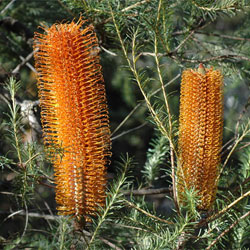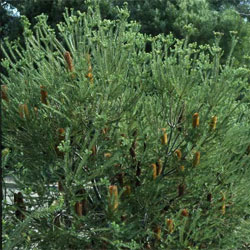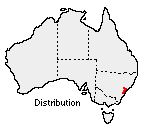Banksia ericifolia subsp. ericifolia
 |
 |
Heath leaved Banksia
Banksia ericifolia L.f. subsp. ericifolia
Banksia ericifolia (Heath-leaved Banksia) is undoubtedly one of the
most beautiful banksias in Australia, with its large striking spikes of yellow
to reddish-orange flowers contrasted with small, linear, light-green to greyish-green
leaves. Not only is it the most colourful of the eastern Banksia species
when in flower, it is also one of the best plants for attracting honey-eating
birds and makes an interesting addition to any garden of Australian character.
B. ericifolia naturally occurs in heath or shrub-woodland vegetation, distributed widely on the central coast of New South Wales to the adjacent ranges between Collaroy and Jervis Bay. It chiefly occurs in soils of sandy loam, deep sand or sand over sandstone in well drained areas.
Historically B. ericifolia is highly valued as it was allegedly the first specimen collected by Sir Joseph Banks at Botany Bay in 1770. Banks did not describe this new discovery however and it was left to Carl Linnaeus who later named the genus Banksia in honour of Banks in 1782.
The cylindrical flower spikes of B. ericifolia are quite large at 4-6 cm wide and up to 30 cm long. Flowers open from the top of the spike down, in which the style characteristically remains a hooked shape. Flowering occurs over an extended period beginning in autumn and continuing through to early spring. They last well as cut flowers or indefinitely as dried flowers.
B. ericifolia, even without flowers, is an attractive, fast growing, bushy shrub growing from 4 - 7 m high. It is most useful as a garden feature or screen plant. The spent flower spikes form woody seed bearing cones with the fruit remaining closed for an indefinite period. These seed cones are an interesting feature of the genus and May Gibbs, writer of children's literature, captured these in her stories of Snugglepot and Cuddlepie in order to portray a "uniquely Australian image".
In cultivation this species has proven to be fairly adaptable, very hardy and tolerant of frosts. Although it may successfully grow in wet areas, it prefers well drained soils and will grow in full sun or semi-shade conditions.
Being an eastern Australian Banksia it remains relatively resistant to the root rotting fungus Phytopthora cinnamomi. Damage by insect predators such as stem borers or psyllids occurs occasionally, but the plant generally remains pest free. Iron deficiency however, is common in this species when planted in soils of high pH or when grown near concrete building foundations. Hence for reliable results the species requires acid soils or alternatively the application of iron chelate to assist in correcting the soil pH. Fertilisers with a high phosphorus component should be avoided.
Propagation is most successful from seed rather than cuttings. Once established it may be lightly pruned to retain its bushy dense habit, however at the Australian National Botanic Gardens in Canberra, plants are rarely pruned so as to maintain their rugged growth form. Certainly heavy pruning should be avoided as this species has no lignotubers.
Text by Kathleen Taylor (2002 Student Botanical Intern)
Name meaning: Banksia ericifolia subsp. ericifoliaBanksia - named in honour of Joseph Banks (see above); ericifolia - was derived from Erica, a genus of heaths in Europe and Africa, and the Latin folium meaning 'leaf' refers to the resemblance of the leaves to those of Erica. |
References
Blombery, A.M. and Maloney, B. (1992). The Proteaceae of the Sydney Region. Kangaroo Press, Kenthurst NSW.
George, A.S. (1996). The Banksia Book. 3rd Ed. Kangaroo Press, Kenthurst NSW.
Harden, G.J., Hardin, D.W. and Godden, D.C. (Eds) (2000). Proteaceae of New South Wales. University of New South Wales Press Ltd, Sydney NSW.
Holliday, I. And Watton, G. (1990). A Field Guide to Banksias. Lansdowne Publishing Pty Ltd, Sydney NSW.
Wrigley, J.W. and Fagg, M. (1989). Banksias, Waratahs and Grevilleas and all other plants in the Australian Proteaceae family. Collins Publishers Australia, Sydney NSW.
![An Australian Government Initiative [logo]](/images/austgovt_brown_90px.gif)

